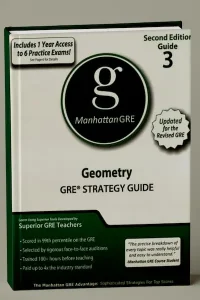Manhattan GRE Guide 3 is an updated for the revised GRE, these strategy guides contain detailed lessons and strategies for question formats that will appear on the revised GRE.
- Included in this all-in-one set are books devoted to each of the test’s major content areas, including Algebra;
- Fractions, Decimals, and Percents;
- Geometry;
- Number Properties;
- and Word Problems.
The Quantitative Comparisons and Data Interpretation guide provides students the understanding necessary to attack each of these unique question types.
For the verbal section, the Text Completion and Sentence Equivalence guide provides a comprehensive approach to the GRE’s vocabulary questions, while the Reading Comprehension and Essays guide equips students with the critical tools and strategies needed to master these portions of the test.
Manhattan GRE Guide 3
We know that you’re looking to succeed in the GRE so that you can go to graduate school and do the things you want to do in life.
We also know that you might not have done math since high school and that you may never have learned words like “adumbrate” or “sangfroid.” We know that it’s going to take hard work on your part to get a top GRE score, and that’s why we’ve put together the only set of books that will take you from the basics all the way up to the material you need to master for a near-perfect score, or whatever your score goal may be. You’ve taken the first step. Now it’s time to get to work!
How to Use These Materials
Manhattan GRE’s materials are comprehensive. But keep in mind that, depending on your score goal, it may not be necessary to “get” absolutely everything. Grad schools only see your overall Quantitative, Verbal, and Writing scores—they don’t see exactly which strengths and weaknesses went into creating those scores.
You may be enrolled in one of our courses, in which case you already have a syllabus telling you in what order you should approach the books. But if you bought this book online or at a bookstore, feel free to approach the books—and even the chapters within the books—in whatever order works best for you. For the most pan, the books, and the chapters within them, are independent; you don’t have to master one section before moving on to the next.
So if you’re having a hard time with something in particular, you can make a note to come back to it later and move on to another section. Simi-lady, it may not be necessary to solve every single practice problem for every section. As you go through the material, continually assess whether you understand and can apply the principles in each individual section and chapter.
The best way to do this is to solve the Check Your Skills and Practice Problems throughout. If you’re confident you have a concept or method down, furl free to move on. If you struggle with something, make note of it for further review. Stay active in your learning and oriented toward the test—it’s easy to read something and think you understand it, only to have trouble applying it in the 1-2 minutes you have to solve a problem.


